JACS综述:无机热电材料低导热性的认识
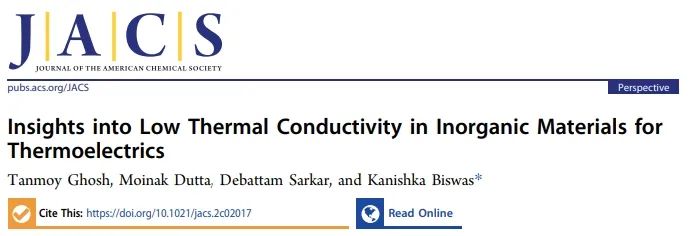
第一作者:Tanmoy Ghosh
通讯作者:Kanishka Biswas
通讯单位:尼赫鲁先进科学研究中心
DOI:10.1021/jacs.2c02017
摘要:
Efficient manipulation of thermal conductivity and fundamental understanding of the microscopic mechanisms of phonon scattering in crystalline solids are crucial to achieve high thermoelectric performance. Thermoelectric energy conversion directly and reversibly converts between heat and electricity and is a promising renewable technology to generate electricity by recovering waste heat and improve solid-state refrigeration. However, a unique challenge in thermal transport needs to be addressed to achieve high thermoelectric performance: the requirement of crystalline materials with ultralow lattice thermal conductivity (κL). A plethora of strategies have been developed to lowerκL in crystalline solids by means of nanostructural modifications, introduction of intrinsic or extrinsic phonon scattering centers with tailored shape and dimension, and manipulation of defects and disorder. Recently, intrinsic local lattice distortion and lattice anharmonicity originating from various mechanisms such as rattling, bonding heterogeneity, and ferroelectric instability have found popularity. In this Perspective, we outline the role of manipulation of chemical bonding and structural chemistry on thermal transport in various high-performance thermoelectric materials. We first briefly outline the fundamental aspects ofκL and discuss the current status of the popular phonon scattering mechanisms in brief. Then we discuss emerging new ideas with examples of crystal structure and lattice dynamics in exemplary materials. Finally, we present an outlook for focus areas of experimental and theoretical challenges, possible new directions, and integrations of novel techniques to achieve lowκL in order to realize high-performance thermoelectric materials.
有效控制热导率和基本了解晶体固体中声子散射的微观机制对于实现高热电性能至关重要。热电能量转换可以直接实现电与热之间的可逆转换,能应用于回收废热发电或改进固态制冷,是一种很有前景的可再生技术。然而,为了实现高热电性能需要解决热传输中的一个独特挑战:开发具有超低晶格热导率 (κL) 的晶体材料。目前已有多种策略用于降低晶体固体的κL,例如纳米结构修饰,引入具有定制形状和尺寸的内源或外源声子散射中心,以及控制缺陷和无序。最近,源于各种机制(如rattling、键合异质性和铁电不稳定性)的固有局部晶格畸变和晶格非谐性也已得到普及。在本文中,作者概述了化学键合和结构化学对各种高性能热电材料热传输的作用。首先简要概述κL的基本方面并简要讨论常见的声子散射机制的现状。然后,通过示例材料中的晶体结构和晶格动力学示例讨论新兴的新想法。最后,展望了实验和理论挑战的重点领域、可能的新方向以及新技术的集成以实现低κL高性能热电材料。
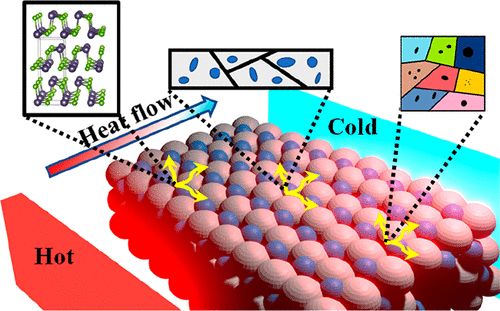
图文摘要
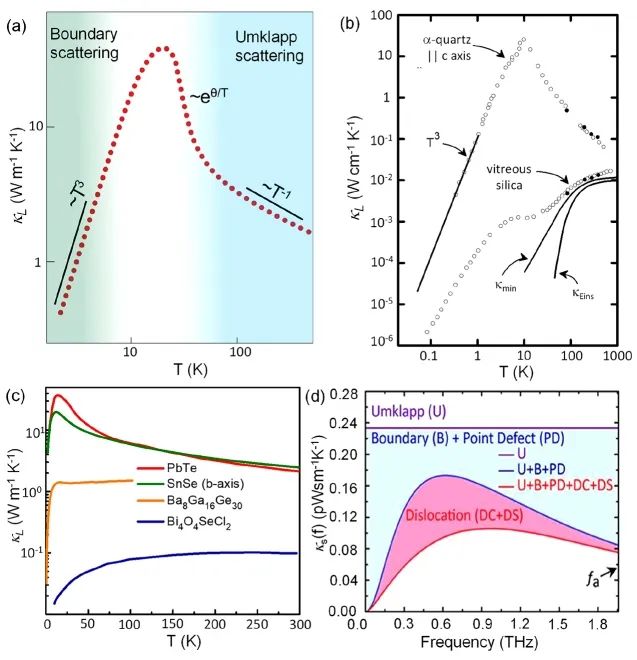
图1 (a) 典型的晶体晶格热导率随温度的变化,在不同温度区域内主导散射机制不同。(b) 晶态固体(α-石英)以及非晶固体(玻璃状石英)的晶格热导率随温度的变化。(c) 不同低热导材料的热输运性质。(d) Bi0.5Sb1.5Te3的频谱热导率显示不同声子散射机制的贡献。
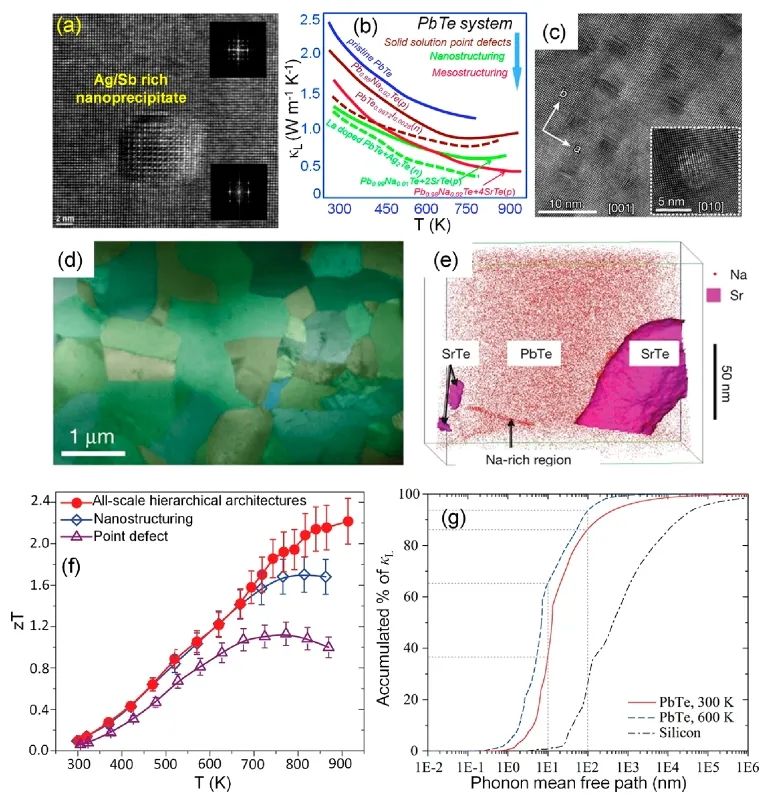
图2 (a) Ag0.53Pb18Sb1.2Te20(LAST-18)中纳米沉淀的TEM图像。(b) PbTe基材料显示全尺度分层系统中点缺陷对晶格热导率的系统性抑制作用。(c) HRTEM图像展示PbTe基体中的SrTe纳米沉淀。(d) TEM图像展示PbTe的中尺度晶粒。(e) APT分析下重建的三维结构。(f) Na掺杂PbTe-SrTe的zT随温度的变化。(g) PbTe和Si中晶格热导率随声子平均自由程的累积率。
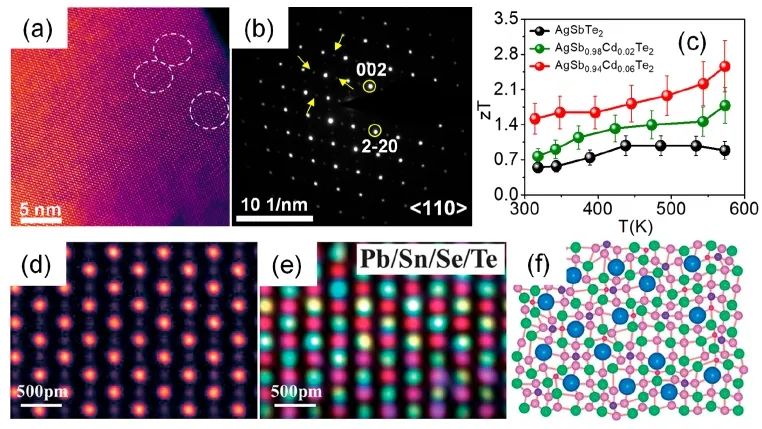
图3 AgSb0.94Cd0.06Te2加强的阳离子无序占位的(a) HR-STEM-HAADF图像以及(b) SAED花样。(c) Cd掺AgSbTe2的zT随温度的变化。(d) 高熵
Pb0.89Sb0.012Sn0.1Se0.5Te0.25S0.25系统中沿[110]方向的HAADF图像。(e) EDS结果。(f) 高熵合金中晶格畸变的示意图。
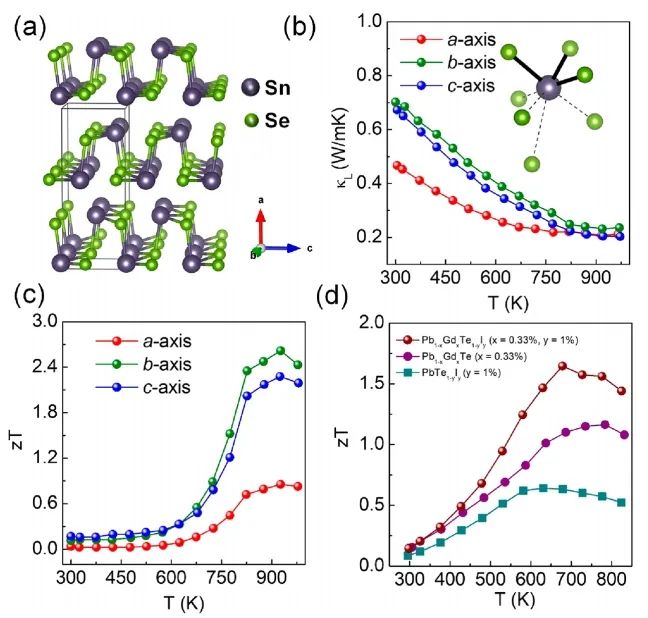
图4 (a) SnSe的正交结构,(b, c) 各向异性的热输运性质以及热电优值。(d) n型Gd掺PbTe的zT随温度的变化。
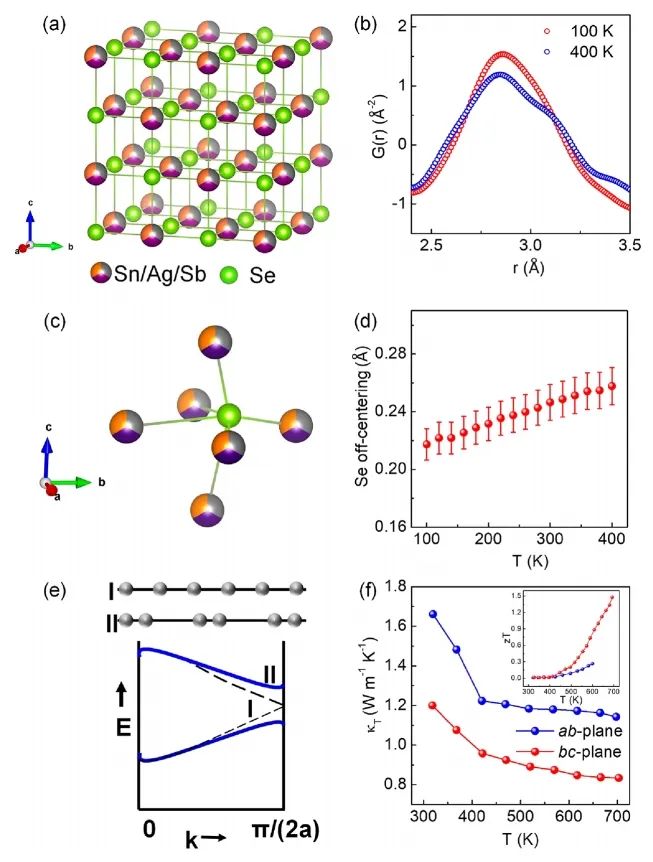
图5 (a) (SnSe)0.5(AgSbSe2)0.5的岩盐结构。(b) 同步XRD第一个峰位对分布函数的非对称性。(c) 八面体环境中Se沿<111>方向局部扭曲的示意图。(d) Se的中心偏离行为随温度的变化。(e) Peierls畸变对周期晶格及声子谱的影响。(f) In4Se2.35沿不同面内晶格热导率随温度的变化。
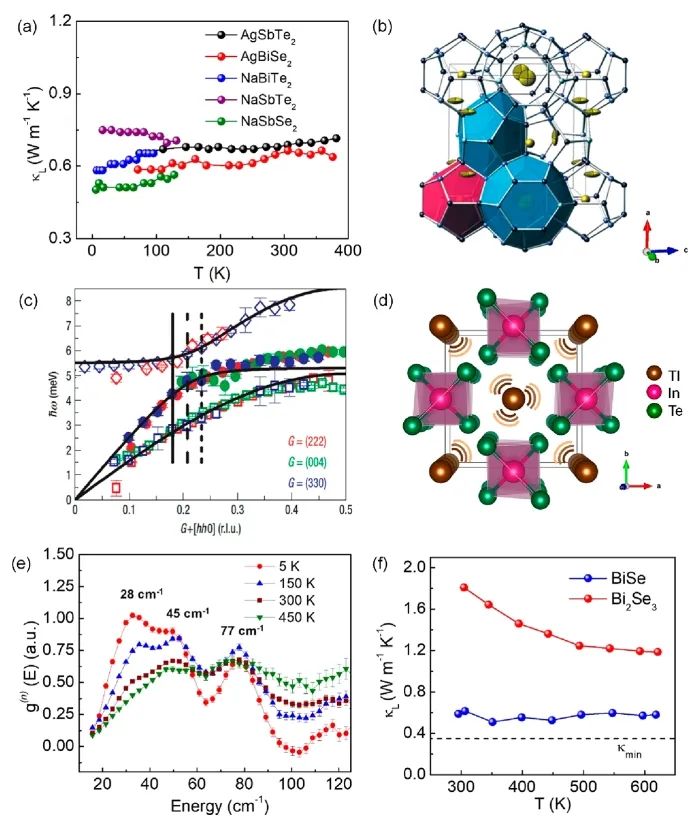
图6 (a) I-V-VI2化合物的热输运性质。Ba8GaGe3016 的(b) 晶体结构以及(c) INS测得的声子谱显示的交叉避免(avoided crossing)行为。(d) TlInTe2中Tl非谐rattling的示意图。(e) INS测得的TlInTe2中中子加权的声子态密度。(f) BiSe与Bi2Se3的晶格热导率对比。
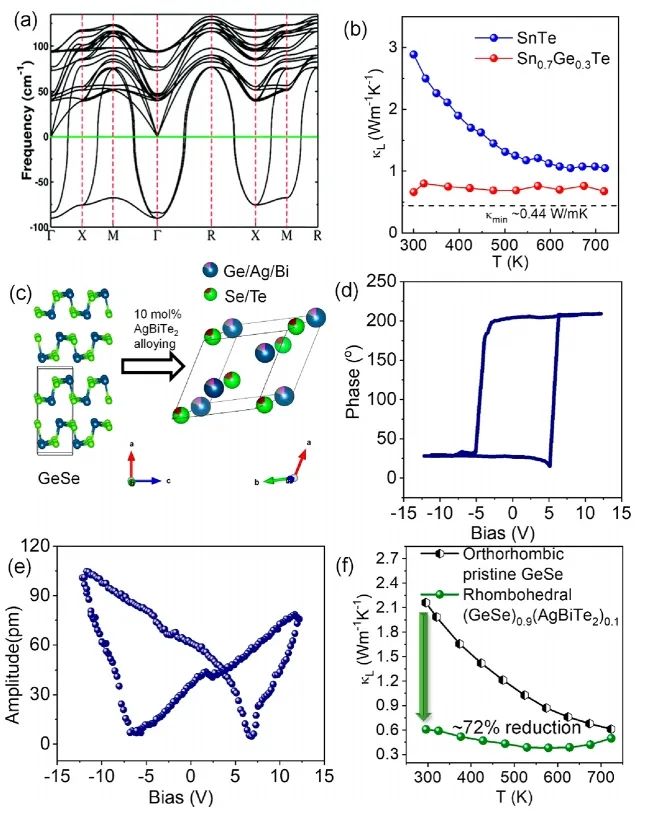
图7 (a) Sn0.75Ge0.25Te的声子谱显示不稳定的TO振动模。(b) SnTe和Ge固溶SnTe的晶格热导率随温度的变化。(c) 固溶10 mol% AgBiTe2后GeSe由层状正交结构演变为菱方结构。室温下(GeSe)0.9(AgBiTe2)0.1PFM信号的(d) 相位以及(e) 强度。(f) 正交相GeSe以及菱方相(GeSe)0.9(AgBiTe2)0.1的晶格热导率随温度的变化。
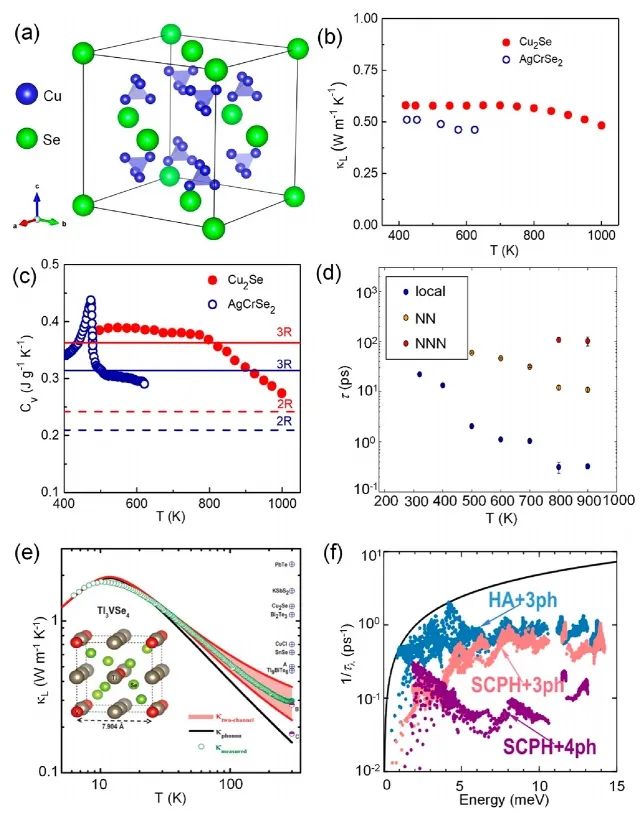
图8 (a) 快离子β-Cu2Se的晶体结构。(b) Cu2Se和AgCrSe2的晶格热导率随温度的变化。(c) 两个材料的CV与Dulong-Petit值相比出现一个掉落。(d) Cu2Se中同一/最近邻(NN)/次近邻(NNN)四面体中的离子扩散停留时间。(e) 考虑不同声子散射后计算的Tl3VSe4的晶格热导率随温度的变化。(f) 不同理论模型下Tl3VSe4的声子散射概率与能量的关系。实线:Cahill-Watson-Pohl最小热导率模型。HA+3Ph:简谐近似下计算三声子过程的弛豫时间。SCPH+3ph/4ph:使用声子自洽近似(SCPH)考虑了温度依赖的非谐性重整化,并计算了三声子/四声子过程的弛豫时间。
